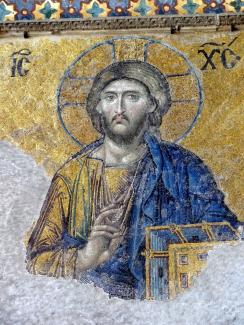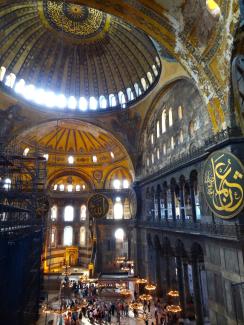Istanbul’s Hagia Sophia. Massive, impressive and inspiring, with 1800 years of history written in layers upon its walls and furnishings, though the stories they tell are more about empires and the men who build them than about God.
Built in just five years, from 532 to 537 AD, it was as the largest cathedral in the world for 1000 years, but served as a church for only 900 of those years, and during that time was beset by waves of religio-political movements that all left their mark. But such was the case even before it was built.
It is the third church built on this spot to honor God and the empire. The first church, constructed as a rectangular basilica with a flat roof, was built by the emperor Constantius II (son of Constantine the Great) in 360 AD and burned down in riots in 404 when the new emperor Archadius exiled John Chrysostom. Another church was built in the same style in 415 by emperor Theodosius II and again burned down in a riot against the emperor Justinian I in 532. Justinian immediately made plans for a much larger basilica to be built with a new 4-pier, central dome design, a new plan that rewrote the history of architecture.
 In 726 the emperor Leo the Isaurian outlawed the veneration of images and all of the statues were stripped from Hagia Sophia. The iconoclasm was reprieved by the empress Irene in 797, but reestablished in 802 when she was overthrown and exiled. More paintings and mosaics were added after repairs to the church in 994, but it was ransacked by Western Christians of the Fourth Crusade in 1204 when it became a Roman Catholic Cathedral. The mosaic of Jesus to the left was made in 1261, when the Byzantines once again took control of the church.
In 726 the emperor Leo the Isaurian outlawed the veneration of images and all of the statues were stripped from Hagia Sophia. The iconoclasm was reprieved by the empress Irene in 797, but reestablished in 802 when she was overthrown and exiled. More paintings and mosaics were added after repairs to the church in 994, but it was ransacked by Western Christians of the Fourth Crusade in 1204 when it became a Roman Catholic Cathedral. The mosaic of Jesus to the left was made in 1261, when the Byzantines once again took control of the church.
In 1453, Constantinople fell to the Ottomans, and Hagia Sophia was desecrated, looted, stripped of it decorations once again, and converted into a mosque. The current minarets were subsequently added in the 16th century and the whole thing was converted into a museum in 1935 when the Ottoman empire fell to Atatürk’s new Republic of Turkey. Subsequently, the carpet was removed to show the floor, plaster was removed to reveal the mosaics, and prayer, both Muslim and Christian, was outlawed in the building.
So much history, so many struggles leaving their mark. I tried to pray but I kept bumping into images of people long dead rushing through Hagia Sophia in a panic as the town lay sieged, wondering if the church would again be burned or looted, and if they would survive the day—ghosts of the long history of struggles for control of this powerful symbol of God’s blessing on this or that empire and this or that emperor, a faith that is difficult to square with that of the poor carpenter I follow.
